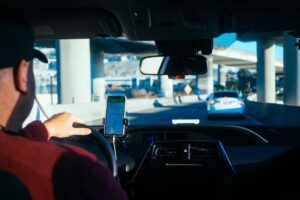
An inattentive driver often underestimates the degree to which their carelessness could impact someone’s life. The Centers for Disease Control And Prevention (CDC) states that engaging with distractions (ie: texting and driving), no matter how brief, is akin to closing your eyes as you’re cruising down a football field. But it doesn’t feel like that, which compels careless drivers to continuously do it. Too often, this leads to needless harm. In 2019 alone, approximately 424,000 injuries and 3,100 deaths occurred as a result of inattentive driving according to the National Highway Traffic Safety Administration (NHTSA).
When people think about distracted driving, they often cite an example of a driver engaging with a visual distraction. This makes sense. When we first learned how to drive, we were taught to always watch the road when we’re behind the wheel. We were taught to look both ways at a stop sign prior to driving forward to ensure that there’s no oncoming traffic that might lead us to crash. We were taught to look at our blind spots before switching lanes to avoid colliding into another vehicle.
But aside from visual distractions, the CDC introduces two more types, namely, manual distraction and cognitive distraction. People often take these two distractions for granted, especially the latter, making them all the more dangerous.
Let’s do a deep dive on each of them!
WHAT ARE THE THREE TYPES OF DISTRACTED DRIVING?
INATTENTIVE DRIVING #1: VISUAL DISTRACTION
This type of distraction compels us to take our eyes off the road. Even something as simple as fiddling with the car radio, or looking at your navigation app (ie: Maps, Google Maps, Waze) on your phone could be considered visual distractions. This is one of the most well-known distractions as it is among the easiest to point out. For example, in a scenario where you are using a ride-sharing app, you could clearly tell if your driver isn’t watching the road and is instead looking at their phone for directions.
We never know what could happen in the one to five seconds our eyes wander elsewhere, so let’s refrain from engaging with visual distractions when driving! If you feel the need to do so, make sure to pull over to the side of the road first then proceed to take care of business.
INATTENTIVE DRIVING #2: MANUAL DISTRACTION
Manual distractions compel you to take your hands off the wheel. This includes driving while eating, holding your phone, drinking your morning coffee, or applying mascara, etc. In order to ensure optimal safety, you need both of your hands on the wheel as you’re driving. Engaging with manual distractions significantly increases your risk of getting into an accident. It could veer you off the lane and potentially hit other cars, effectively endangering your life as well as others. It could bar you from making quick life-saving driving decisions, like if a child were mindlessly standing on the road and the drink in your hand makes it significantly difficult to steer clear.
Even with our eyes on the road, having one hand less on the wheel is dangerous! If there’s a pressing matter you need to attend to, park elsewhere and take care of it before hitting the road.
INATTENTIVE DRIVING #3: COGNITIVE DISTRACTION
Perhaps the most sinister of them all, engaging with a cognitive distraction compels you to take your mind off of driving. This includes daydreaming, engaging in a conversation, or basically anything that is mentally distracting you from the task at hand. Unlike visual distraction and manual distraction, cognitive distraction is often undermined because you could still engage in it while keeping your eyes on the road and your hands on the wheel. Being mentally ready to drive constitutes a significant part of safe driving, a factor people underestimate. If you’re ill-equipped to drive due to some mental distractions (ie: work stress, driver’s anxiety, etc.), then you could make poor driver’s choices that could cost you your life as well as others’.
To rid yourself of cognitive distractions, make sure to remind yourself here and there to solely focus on the task at hand.
CONTACT OMEGA LAW GROUP
You could rid yourself of all distractions to ensure an optimal safe drive, but by some stroke of bad luck, you could still get involved in a car accident. We trust that you have continuously implemented the safety measures necessary to protect yourself and others on the road, but you also need to prepare yourself for when the worst occurs. We at Omega Law Group are happy to help. Give us a call at 310-526-8383 or visit our Beverly Hills location at 9454 Wilshire Blvd., Suite 830, Beverly Hills, CA 90212.





